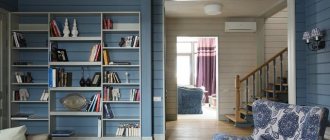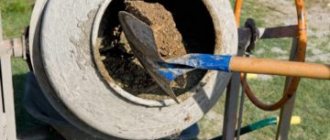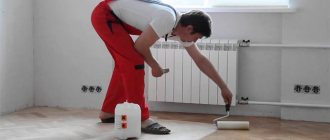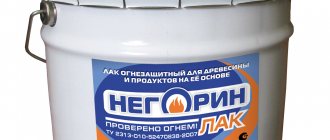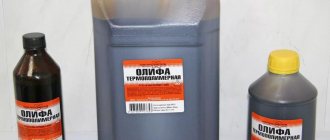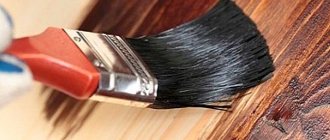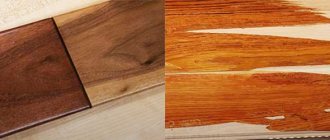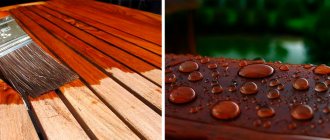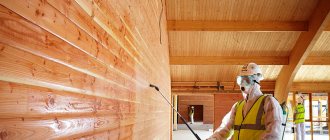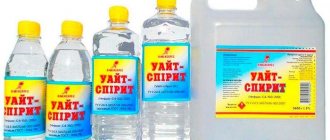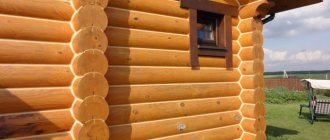Articles
All photos from the article
The beauty of wood is that it looks great on its own, you just need to show its texture. Color can be used to obtain the desired shade. Sometimes, for example, light wood needs to be slightly darkened, and it is in such a situation that color comes in handy.
Wood treated with tinted oil
Understanding the terms
Tinting wood varnish (as well as stain, impregnation and other means) means gradually adding dye until it acquires the desired shade. That is, color is a dye that is gradually added to the solution.
Note! For each type of wood treatment product, you should use a different type of color. Otherwise, it may simply not dissolve when stirred, resulting in a suspension that cannot be used for processing.
As for which color to choose, it is recommended to adhere to the color chart when purchasing it. It is also useful to know that colors that use organic pigments are not particularly resistant to light. Therefore, for outdoor work it is better to use a color scheme that uses inorganic pigments.
In the photo - a color map for selecting the desired shade
There can be several hundred shades of color; the common types of tinting wooden stairs alone include about 50-100 shades. But if suddenly the color palette is not enough, then you can always mix 2 different colors and get your own shade.
In this case, it is recommended to first experiment with a small amount of color and test the resulting tinted varnish or stain on an unnecessary piece of wood. A sign that everything went well can be considered a smooth surface after drying, the absence of drips and uniform coloring.
First you need to test the tinted varnish or stain on a piece of wood.
see also
Comments 21
Add the base to the binder until the desired darkness is achieved. Apply the required number of layers and clear varnish.
I don't know what a binder is)
This is a clear base
Squeeze out a dozen refills from a ballpoint pen and tint as you please. Just not gel ones. Ordinary ones like the Soviet ones
jet black pigment a couple of drops
Well, not everyone has PPG Deltron))
add black candy and you will have a transparent tinting varnish
Add acrylic paint (not base) to the varnish of the color you want, mix well and drop a drop onto a piece of white paper to see how the varnish has darkened
so it won't be transparent
There will be a varnish with a shade of your paint
it means you add black acrylic and you will be happy only after each added portion of paint, mix thoroughly and check what happens, if you were in Grodno I would show you how it gets in the way
I support... I darkened my taillights this way, but added a base...
it means you add black acrylic and you will be happy only after each added portion of paint, mix thoroughly and check what happens, if you were in Grodno I would show you how it gets in the way
Why should you add acrylic and not a base? I once tinted it with just a black base - it turned out just right.
Acrylic varnish and acrylic paint are compatible, but the base (nitro) destroys the varnish formula
It’s logical, but it’s not clear what this “destruction” entails. Based on experience of use, I did not notice any deterioration in properties. Although, of course, it is better to stick to technology in everything.
if you add solvent to the varnish it becomes soft
why? it only improves spreadability, for example you can pour the same D800 horseradish into a good mirror without a solvent. And the fact that the layers come out thinner is just another +1 layer and that’s it. And according to technical regulations, in most varnish standards, the solvent is poured in small quantities and does not change the properties of the varnish.
How to tint correctly
In a nutshell, the instructions for tinting are that the dye is slowly added to the stain, paint, etc., after which it is simply mixed thoroughly. The dye is added gradually and when the liquid reaches the desired shade, you can proceed to processing the wood. However, there are a number of nuances, depending on what needs to be prepared - varnish, stain or wood paint.
Preparation of tinted varnish
The main purpose of the treatment is to create a durable film on the surface of the wood; after the varnish has dried, it will protect the wood from moisture penetration into it, and the texture will also appear. Tinted wood varnish differs from regular varnish in that after processing the wood texture not only appears, but is also painted in the appropriate shade.
Sometimes even famous manufacturers can make mistakes in the color chart, so it makes sense to take care of preparing the varnish of the desired shade with your own hands. Dyes are usually sold in the same stores as the wood treatment products themselves. You can even try to negotiate with the operator of the coloring machine and the color can be cast into your container. This is just an ideal option, but it all depends on the mood of the employees.
The required color can be obtained from the tinting machine operator
You can try to do tinting using improvised means. For example, there are references to the successful experience of adding water stain to acrylic varnish (a kind of color for wood varnish). The resulting solution is quite pale (even with a high concentration of stain), so it is suitable in cases where strong darkening is not needed.
As for the process of processing a wooden product, it is recommended to adhere to the following sequence:
- the surface is carefully polished. immediately before applying a layer of varnish, you need to wipe the surface to remove dust;
The surface must be perfectly smooth
- then the first layer of tinted varnish is applied;
Note! The entire product is varnished at once; in no case is it recommended to break the surface into sections. If you prepare the next batch of varnish later, it is unlikely that you will be able to get the same shade, but the difference will be noticeable.
- Wood tinting is done in at least 2 layers. But if the surface is quite porous, and the varnish itself is not very saturated in color, then the number of layers can be increased to 3-4;
- It is recommended to make the last layer colorless.
Tinted oil and impregnations
- regular oil paints. They can be mixed at room temperature;
- You can also use gouache. but so that the water does not interfere with the process, the mixture will have to be heated, the water will evaporate;
You can use gouache to tint oil.
- in the past, people also used dyes such as ordinary ash. For example, tinting wood oil with ash will allow you to achieve a dark gray or even black color, it all depends on the concentration of the dye. Soot, colored clay and other natural materials can also be used;
A dark color can be obtained by mixing soot or ash with oil.
- If you buy a dry color and mix it with oil, you will get an analogue of purchased oil paint. Since their prices are comparable, there is no point in messing around with mixing oil and dye; it’s easier to just buy paint.
It should be remembered that when working with oil, too high a concentration of dye gives a more saturated color, but the properties of the oil are lost. That is, it no longer protects the wood from moisture so well and over time the coating will need to be renewed. So the color for wood oil should be added with an eye to the balance between the properties of the oil and the color saturation.
In the case of impregnations, the color after treatment is usually secondary, but even at this stage it is possible to ensure that the wood acquires a noble appearance. If a part of the structure is being processed that will not be visible, then iron oxide can be added to the solution, just so that it can be seen which part is processed and which is not.
Imitation of "Venetian"
How else can you beautifully paint decorative plaster? Apply decoration in the style of “Venetian plaster”, imitating natural stone. To create such a coating, stone chips are used, which is considered an expensive finishing material. You can use analogues - plaster compositions based on gypsum, painted in the desired color, fixing the materials.
Technologically, the “Venetian” is created as follows:
- preliminary preparation is carried out on the wall - dust accumulations and dirt are cleaned, cracks and other defects are sealed with putty;
- The base material is applied to the wall surface. Which roller should you use at this moment? It is better to use a long-haired tool, painting hard-to-reach areas with a brush;
- as soon as the layer dries, a decorative shade is applied - gilding, metallic, bronze or silver. Use a foam or short-haired roller. Metallic is applied with light strokes; when rolling the roller, little force is applied so that the base coating is visible;
- At the final stage, the decorating layer is fixed. For this purpose, use water-based varnish compositions, additionally diluted and mixed with glitter (one teaspoon of glitter for each liter). The prepared solution is applied with a roller.
Tinting parquet with tinted varnish
Tinting parquet flooring is not such a simple process as it may seem to many. Many nuances and pitfalls await an inexperienced person. How to tint, what technology and technique to use, what the output will be, and other answers, see the parquet tinting page.
In this article we will dwell in detail on the possibility of using tinted varnish, which is widely offered in all construction markets and other sites. Tinted varnish for parquet is sold everywhere, but those who offer it have hardly ever tried to use it themselves! Tinting varnish can hardly be called an excellent means for tinting parquet or floorboards.
Application technology
Each manufacturer's use is indicated on the label. But there are standard methods:
- Immersion - when a wooden element is immersed in a hot composition and left to soak for several days. Then it is taken out and dried on a warm surface.
- Vacuum impregnation - the product is placed in a special device, where, under the influence of a vacuum, the oil penetrates deep into the wood.
- Two-layer application - performed using a brush or a piece of foam rubber when finishing the premises.
Let's take a closer look at two-layer application, which is suitable for treating wooden floors, stairs and walls.
Two-layer application
To complete the finishing you will need tools and materials:
- Oil.
- Wax.
- Wide tassel - flute.
- Sanding paper of the finest fraction.
- Cotton rags.
- A piece of clean suede.
The product is first cleaned of the old coating, and the surface is sanded using sandpaper. Use a soft brush to sweep away dust. Prepared wood absorbs oil better, and the protective properties of the coating will be higher.
Before work, the oil is brought to a boil twice. Thermal preparation will reduce the drying time of the impregnation. You need to cook the flaxseed product in a water bath, in small portions. As soon as the oil boils for the first time, remove it from the heat and allow to cool. Then the procedure is repeated. Before application, the hot product is stirred so that the color is more uniform. Modern wax compositions do not need to be preheated, but they will take longer to dry.
Use hot impregnation with caution and wear protective gloves.
- A brush or sponge is soaked in linseed oil, which is applied liberally to the wood using a blotting motion. Movements are performed along the fibers.
- Within two hours, the surface of the wood is impregnated.
- A second layer of hot impregnation is applied. The surfaces are allowed to dry for 2-3 hours.
- Take a soft rag and use it to remove excess impregnation from the tree.
- The surface is polished with wax or varnished.
Beeswax is heated in a water bath and rubbed hot into the wood until the surface acquires an even shine. But it is not necessary to cover the impregnation with wax; you can use the old method of polishing - using a thick suede cloth. Rub the surface with suede until it shines, using circular movements. But adding shine to wood is a long and painstaking process. It may take several weeks to treat a large area.
When using linseed oil to protect wood in your home, the application technology is followed. You will have to work with a heated product, so take care to protect your hands and eyes. By impregnating the wood, the oil will protect it from moisture, sun, fungi and mold. Small cracks will disappear on the surface, and the pattern will become clearer. To decorate inexpensive wood like oak or mahogany, impregnations with tinting effects are used, which can be purchased at any specialized store. For simple processing, the most inexpensive unrefined oil is suitable. It is advisable to wipe the top surface with wax or sand it until shiny with a suede cloth.
All photos from the article
The beauty of wood is that it looks great on its own, you just need to show its texture. Color can be used to obtain the desired shade. Sometimes, for example, light wood needs to be slightly darkened, and it is in such a situation that color comes in handy.
Tinted varnish is not a professional tinting product!
Let's start with the fact that even on colorless varnish, sagging and overlaps are clearly visible after drying, although small differences in the thickness of the application are not noticeable. This is due to the fact that the eye only perceives changes in the degree of gloss, but the color scheme does not change when the thickness of the varnish film changes. When using tinted varnish, everything is different; the thicker the layer, the darker it is. Even small differences in thickness will clearly stand out. It is impossible to apply varnish over a large area perfectly evenly, without overlapping layers.
Let's explain it in our fingers. It’s easy to cover a small lamella with one stroke of the brush and place it on a sample, but it’s impossible to roll it out with a roller, much less apply it with a brush, without overlaying part of the varnish from one pass onto another. The tinted varnish will not spread, and the transitions and joints will be distinguished by dark spots and stains.
See an example of applying Tikkuril tinted varnish with a brush and the consequences of this on the parquet tinting error page.
Therefore, when asking the question: Why do stains remain on wood after white or colored varnish?, you are most likely confusing the stains with ordinary stains.
Tinted varnish is never used by real craftsmen!
But its use is still possible. Firstly, using tinted varnish significantly reduces the cost of the process. If you know how to do something, work without haste, and a few dark spots will not be a tragedy for you, then you can easily tint your dacha floor with this product. Let's give some advice. Use only a roller and a good quality one. Apply varnish only along the boards, exactly the width of the narrow section. Try to roll from wall to wall in one motion. Do not try to correct anything in the already varnished part. With the next pass, under no circumstances climb onto the already varnished part. Carefully consider the exit from the room so that by moving the roller along the finishing row, you can easily leave the room. Well, something like this.
Yes, still! If you are satisfied with the result of one of the layers, use the colorless version for the next coatings!
Tinted varnish is good for use on completely “killed” floors in apartments and industrial premises. It covers stains, rot and other damage well. True, in this case the structure is completely lost, and the floor takes on the appearance of being painted. The so-called “deaf” tinting of parquet. When applying several layers of tinted varnish, a completely uniform dark film is formed. At the same time, the reflective ability changes and the glass effect disappears when all layers are visible throughout the entire depth. In this case, color differences in thickness are leveled out, and the floor looks more or less uniform.
But such a coating is no longer tinting in its true sense, and is rather called painting.
After reading this article, you will be able to understand why it is not advisable to use tinted varnish to tint parquet or boards.
Source: parket-all.ru
Summary table of defects
To make it easier to navigate the defects, below is a table of the main defects.
| Defects (types) | Causes | Corrective Action |
| Peeling, swelling | Constant influx of moisture or plastering of a wet base | The loose, swollen plaster layer is beaten off with a hammer, the base is dried, and plastered again. |
| Dutiki | Poorly slaked lime | The coating is wetted, removed and the area is re-plastered. |
| Peeling | The base is not properly prepared, the solution is applied “dry” | The exfoliated areas are knocked down, properly prepared, and plastered. |
| Cracks | Violations at any stage of plastering, as well as shrinkage and movement of building structures | Surface cracks are ground, deeper cracks are repaired with sealant or mortar, following the technology |
| Wall plane fractures | Incorrectly installed beacons | The finishing is removed and the wall is re-plastered. |
| Rust spots | The beacons left in the coating have rusted, hidden pipes are leaking, | The wall is being tapped, beacons are removed, pipes are repaired, bioaggressors are removed, stains are cleaned |
| Efflorescence | Release of groundwater into materials | Carrying out waterproofing and sanitizing works |
Varnishes for wood and more
Today we choose varnish for wood (fibreboard, chipboard, MDF, plywood) as well as for coating painted surfaces made of these materials.
Unlike wood glue, there are a huge variety of varnishes. Therefore, I will only talk about those that I have tried myself. These are one-component varnishes, most in demand by both professionals and home craftsmen. Let's go, as always, “bottom up.”
1. Nitrocellulose varnish (NC). Or just nitro varnish.
In principle, this is a normal varnish. Simple. I started covering my first creations with it. By default, this varnish is colorless, but stores sell several shades of it. I don’t know if it’s possible to tint it yourself; I haven’t tried it. Theoretically, it is possible, using a dye on an identical basis. Suitable for covering inexpensive items.
Pros: dries quickly, does not bubble when applied, cheap. Cons: The coating is rather weak, wears out and gets scratched quite quickly. Poor light fastness. Stinky! Therefore, you need to work in a well-ventilated area. However, after it dries quickly it stops smelling. Brushes can only be washed with solvent.
Consists of natural alkyd resins in an organic solvent. The varnish is not bad. I started using it after I became disillusioned with NC :)) The line of alkyd varnishes is divided by hardness and moisture resistance.
Pros: quite durable, looks good in terms of gloss (the markings don’t lie), good moisture resistance, light fastness. Reasonable price. Cons: Smelly! A little less than nitro, but long lasting. It takes a long time to dry, up to a day. And all this time it exudes a smell. Therefore, the use of this varnish in inhabited areas is almost impossible. Bubble when applied with a brush! Small air bubbles remain in the varnish layer and there is only one way to remove them from there - let the varnish dry and then remove the bubbles with sandpaper. And then cover it again with a new layer. Still the hemorrhoids! Why does it bubble? The jar needs to be shaken if the varnish contains matting additives (more details below). Stirring creates bubbles. Personally, I used yacht semi-matte and furniture semi-matte from Marshall. Until acrylic appeared.
Beneficial properties of flaxseed oil
Flax seed is a very popular product in home cosmetology. Flaxseed oil is used for cosmetic purposes to care for the skin of the face and body, maintaining the beauty of hands, nails and hair. This product has a rich chemical composition, which allows it to provide complex beneficial effects on the skin:
- unsaturated fatty acids omega-6 and omega-3 (in terms of their content, flaxseed oil is comparable only to fish oil) help cells regenerate, activate collagen production, promote tissue restoration, and eliminate fine wrinkles;
- niacin (vitamin PP) increases cell tone, eliminates flaking, and prevents the development of skin cancer;
- thiamine (vitamin B1) moisturizes and smoothes the skin, it is indispensable for excessive dry skin;
- choline (vitamin B4) relieves skin irritation and softens it, prevents the appearance of pimples and acne;
- phylloquine (vitamin K) improves complexion and general skin condition;
- folic acid (vitamin B9) relieves inflammation, protects the skin from harmful influences, fights acne and acne.
The benefits of flaxseed oil for skin have been proven for a long time. Regular use of flaxseed oil or flax seed decoctions allows you to solve a number of problems of both cosmetic and medical nature:
- cure skin prone to inflammation and get rid of acne;
- get rid of dryness, redness, peeling or itching of the skin;
- relieve dermatitis, eczema or psoriasis;
- prevent sagging skin, “tighten” the oval of the face;
- smooth out early wrinkles, increase elasticity and tone of the skin;
- reduce the sensitivity of overly delicate skin;
- improve the appearance of flabby, lacking tone or aging skin.
Tinted wood varnish Cetol TSI
Seasonal PROMOTION for painting a wooden house at a competitive price
Attention!
The quantity of goods is limited, check availability with the manager.
Cetol TSI: Tinted semi-matt alkyd-based varnish on wood for interior use. Excellent tint for wood. Protective, wear-resistant, water- and dirt-repellent coating Cetol TSI is suitable for painting any indoor wood structure, such as doors, baseboards, suspended ceilings, furniture and shelving. The coating is also suitable for wet areas, such as bathrooms. Does not turn yellow.
We color Cetol TSI according to the fans of the Sikkens Natural Balance and Cetol Design Classic . To order flowers from these catalogs, follow the link Cetol TSI Satin plus.
Characteristics: Easy to apply. Resistant to impact and abrasion. Good resistance to water and non-aggressive detergents. Content of volatile organic compounds G. U. At 60 o (ASTM D 523).
Service life: Depends on the height and location of the painted object, as well as the quality of the wood, conditions and method of application, etc.
Packaging: 1 l,
Shelf life: at least 1 year in unopened original packaging. Store in a dry place at a temperature of 5-30o C.
Application system:
Important!
Wood moisture content should not exceed 14%.
| Old price | New price | |
| 1l. | RUB 1,399.92 | RUB 700.00 |
New unpainted wood: Apply to previously prepared wood (sanded and, if necessary, degreased with M600).
Some types of wood produce large amounts of extracts, and softwoods can be very resinous. In this case, the existing resin pockets should be removed, and the remaining resin should be washed with a cotton cloth moistened with M600 degreaser (it is recommended to change the cloths as often as possible). Allow the solvent to completely evaporate before painting. It is recommended to use special eye and hand protection.
Stir the varnish thoroughly before applying. For best results, it is recommended to use a good quality, soft, long-haired brush. Apply varnish in 3 layers (drying time between layers is 16 hours). To make the finish look beautiful, it is recommended to follow 3 rules: 1. Make as few strokes as possible; 2. Do not apply too thickly, as brush marks will remain; 3. Apply strokes along the wood grain.
Source: domkraski.ru
Announcements on NN.RU - Construction
Milan kitchen table new with free delivery to your doorstep in the city of Nizhny Novgorod Dzerzhinsk. Size: 1154*752*756 mm frame: legs. Price: 4,500 rub.
Dining group new collection free delivery within the city of Nizhny Novgorod Dzerzhinsk. Dzerzhinsk furniture factory Dastorg.
Carved entry posts for stairs made of oak, beech, ash, pine! From us you can buy carved pillars and balusters of various types and... Price: 7,000 rub.
Log house 6*9 five-walled, 2.8 m high, planed logs. Price: 360,000 rub.
«>
Decorative varnish - shine and protection for your plaster!
Decorative plaster does not require additional processing - it is classified as a finishing coating and forms a durable, aesthetic surface. However, if you want to emphasize the texture, add shine and add shades, special glazing compounds are used. In this article we will look at what finishing varnish is used to cover walls, how to prepare it yourself and what to apply it with.
Summarizing
Tinting varnishes, oils and wood impregnations is a creative process, and therefore very exciting. By adjusting the concentration of dye in the wood treatment liquid or oil, you can achieve almost any shade. As a result, even simple pine looks exquisite after processing.
The video in this article shows an example of using acrylic varnish tinted with a regular water-based stain.
Because You are not logged in. To come in.
Because The topic is archived.
Because The topic is closed.
What is a glaze composition
Glaze varnish is a coating designed to improve the decorative properties of a material. It is used on smooth and textured plasters, forms a durable transparent film, gives the desired shade and/or shine. It does not hide the color and texture of the plaster, but only emphasizes its relief.
Glazing varnish is used for:
- Improving the appearance of the coating. Different types of composition and application techniques give different effects: to emphasize the relief structure of the material, to give a pearlescent shine to the coating, to give the wrong color of plaster the desired shade.
- Protection. After drying, the composition forms a vapor-permeable film, which enhances the strength of the main decorative coating. Plaster treated with varnish is more resistant to mechanical stress, is not afraid of dampness, and does not fade under the influence of sunlight. Dust settles less on uneven surfaces, and if necessary, the wall can be washed. Finishing with plaster in wet rooms (bathrooms) must be completed with final varnishing.
The composition is environmentally friendly and can be used for finishing residential premises.
Below in the photo you can see how decorative plaster coated with varnish looks in different colors.
Is this acceptable?
There are several main types of coatings:
- Venetian;
- Moroccan;
- decorative plaster.
There are also textured mixtures that create three-dimensional patterns.
Venetian and Moroccan plaster mixtures create their own shades after application, so they do not require painting.
As a rule, this type of work requires textured solutions.
Most often, color is added to the plaster mixture before it is applied to the surface; there is the option of purchasing plaster in a shade that suits you. The third way to get the required color is to paint the wall surface finished with plaster, which reacts well to varnish and coloring compounds and waxes.
To ensure that paintwork materials applied to the plaster layer are applied evenly, do not come off, are securely held, do not develop cracks, and retain their original shade for a long time, it is necessary to use suitable materials and follow a number of recommendations.
What varnish to cover the walls with?
Glazing varnish is a water-based acrylic solution + targeted additives. Available in 2 options:
- colorless - used unchanged or tinted independently;
- colored - completely ready for use; you cannot add paint or dye to it.
The composition may contain glitter, and the surface covered with it becomes pearlescent.
Glazing varnish, depending on the type, can be matte, semi-gloss or glossy.
Almost every manufacturer of decorative plaster also has a varnish for coating it. But it is not necessary to use materials of the same brand; you can choose any, for example, VGT, San Marco, Perlacheo, Tex, Poliver, Dali, Bayramix, etc.
Preparing the base
So, how to paint decorative plaster with your own hands? Before applying paint, the wall should be prepared, for which:
- dust accumulations and other contaminants are removed;
- uneven areas are puttied;
- before applying the decorative plaster mortar, the wall surface is sanded and coated with a primer;
- if you intend to create a structural coating, leveling is not necessary - we immediately proceed to priming and subsequent plastering.
How to tint varnish
If you can’t choose a color from ready-made compounds, you can purchase a colorless one and get the desired shade yourself. To give the desired color, special solutions are used - tints. Additionally, you will need scales, a mixing container and a drill with a mixer attachment.
- Pour the required amount of varnish into a container and weigh it.
- The maximum allowable amount of color is 10% of the base. It is advisable not to pour out all the paste at once, but add in small portions and then stir.
- Then apply the liquid to a sample of the coating and wait until it dries to evaluate the result.
It is important to remember that acrylic compositions may darken slightly after drying.
Tinting – adding color
Plaster material for wall repairs, purchased in a store, is often tinted before application. This ensures uniform painting of the wall surface over the area and thickness of the mortar layer. Consequently, after the formation of scratches and small chips, the shade of the covering layer is retained, and minor defective areas are not so visible.
Plaster mixtures are tinted with one or more pigments to obtain the required shade. The prepared solution is mixed, the color is given one tone darker than desired, because when the solution dries, it becomes a little lighter.
To make the whole room look monochromatic, it is recommended to immediately prepare and paint the required amount of plaster mortar.
How to make it yourself
Glazing compounds are produced by different manufacturers, but most of them are expensive. If you want to save money, you can prepare the solution yourself.
For this you will need:
- scales;
- wallpaper glue;
- acrylic panel varnish (matte or glossy, depending on what kind of coating is required);
- drill with mixer attachment;
- container for mixing the solution;
- color or water-based paint;
- additives (sparkles - glitter).
Recipe . The glaze solution (glaze) will consist of 2 parts glue, 1 part varnish and ½ part paint.
- First, prepare the glue by diluting the dry powder according to the instructions indicated on the package. Mix thoroughly and leave until the flakes are completely dissolved in the water. It is not advisable to store the prepared liquid for a long time, so you need to calculate the required volume and prepare as much as you need for work.
- Panel varnish is poured into a container with ready-made glue and mixed thoroughly.
- Then paint is added. If you use color, then pour in a smaller amount (not ½ part).
- At the same time, add glitter. Add very little additives - a few grams per 1 kg of solution is enough.
Dyeing process
How to paint walls after applying decorative plaster? Use one of the following methods:
- in 1 or 2 colors;
- painting with a dry brush;
- applying the Venetian mixture;
- color change due to lightening.
One color
This method is considered the easiest. The work is carried out in two stages, the excess amount of material is shaded, and the decorative covering layer is fixed.
Technologically, the process looks like this:
- the prepared solution is distributed evenly over the wall. Furrows and other relief elements are carefully painted over by rolling out a roller;
- As soon as the paint for decorative plaster has completely dried, its layer is secured with varnish.
Application (glaze)
The glazing composition is applied to completely dry plaster. If there is dust on the surface (from grouting, for example) or dirt, remove it. Decorative finishes are varnished without preliminary priming; there is no need for it.
When carrying out work, the humidity in the room should not exceed 75%, and the temperature should be from +5 to +35 °C. When the primer layer has dried, begin application.
Application methods: sponge, roller, paint brush or spray gun.
Important! The solution containing glitter must be stirred constantly so that the additives do not settle to the bottom of the container.
- Work starts from the corner. The wall is mentally divided into squares with an area of 1 m². First, they process one, then immediately move on to the next, not allowing the first area to dry out. If you take breaks, the liquid will dry out and the transitions will be noticeable. There is no way to fix this.
- If the liquid has thickened, or you need to get a light, almost invisible coating, the liquid is diluted with water. The composition has virtually no odor during application and dries quickly.
- The composition is applied in separate strokes, without trying to completely paint the surface. Movements can be straight or circular, randomly directed. After treatment, even before the liquid dries, you need to shade the surface. Since the solution dries quickly, it is recommended to work together: one applies the composition, the other shades it.
Drying time depends on the specific composition, on average 1-2 hours.
Material consumption : about 100 g per 1 m². When using a spray gun, consumption is reduced.
If the goal is to create a light coating or additional protection for the plaster, then one layer is enough. The second is applied when it is necessary to give the surface greater color saturation. An additional layer can be made either with the same solution or with a different color. Between applications take a break of 1-2 hours.
Patient No. 5 - Vertical deviation no more than 5 mm? No, I haven't.
What's wrong
- №1 — It is obvious that the wall is incredibly crooked and the vertical deviation exceeds all imaginable norms — in some places more than 10 mm. Let me remind you: The deviation for the height of the room should not exceed 5 mm according to SNIP and 2 mm according to TU (technical conditions).
How to fix
It’s easier to dismantle and rebuild than to fix it, or consider applying a new layer of plaster on top - if there is such a possibility and economic feasibility.
If the deviation was within 2-3 mm, then we could try to solve the problem with putty. In our case, the gap is too large.
What if you don't fix it?
Then the wallpaper will go crazy and end up ugly in the corner. There's a wall there. The cabinet or set will stand up a little unevenly and will reveal the unprofessionalism of the finishers and your frivolous attitude towards the rough finishing of your own home. Simply put, gaps between the furniture and the wall will be visible - crooked, unpleasant gaps.
Protective properties of oils
Unlike most wood preservatives, oil does not form a thick film, maintaining the vapor permeability of the material. At the same time, the hydrophobicity of the surface increases significantly - upon contact with liquid water, the absorption of wood is practically zero. However, a wooden product remains susceptible to shrinkage and swelling; coating with oil does not eliminate these phenomena.
The protective effect of the oil is to compact the outer layers of the tree, thereby preventing the penetration of insect pests into the mass. Due to the absence of paths for moisture penetration, the tree becomes least susceptible to organic damage by mold, mildew or blue staining.
Oil also preserves the color of wood well, which is especially important for exterior decoration of a house. The oil crust that forms on the surface effectively scatters sunlight and limits the flow of oxygen.
Due to this, the rate of cellulose oxidation and the associated appearance of a grayish coating are reduced significantly.
All these properties are more pronounced the thicker the oil used for coating and the more layers are applied. Oils are characterized by the division of protection into two barriers: an internal one, achieved by impregnation of the pores, and an external one, formed when a thin oil film dries on the surface. It should be remembered that oil-impregnated wood has a higher thermal conductivity than dry wood.
Varieties
Typically, mixtures containing alkyd resins and polyurethane are used to coat wooden products. There are two types of these solutions:
- alkyd-urethane “yacht” varnish. This composition is used for painting boats and yachts above the waterline;
- parquet composition. It is usually used for the protection and decorative treatment of wooden and parquet floors.
Each of these varieties can be applied to any wood surface. Yacht varnishes are used to protect wooden buildings outdoors. Yacht varnish compositions are usually used to treat verandas, gazebos, terraces, garden buildings, fences, and wood fences. And parquet varnishes are applied to any wooden products during interior work. In addition to the floor, parquet solutions can be applied to staircase railings, window frames, furniture, doors, baseboards, etc.
Both yacht and parquet varnish solutions are available in one-component and two-component versions. Although two-component ones are more expensive, they have better wear resistance and durability. Varnishes can also be classified according to the type of gloss; there are glossy, semi-gloss and matte mixtures. Matte solutions are usually used in very dirty areas and in high traffic areas. The matte layer is easy to clean and shows much less damage. Glossy mixtures strongly reflect light, so they are more often used in rooms with poor lighting or on decorative, elegant products and details.
